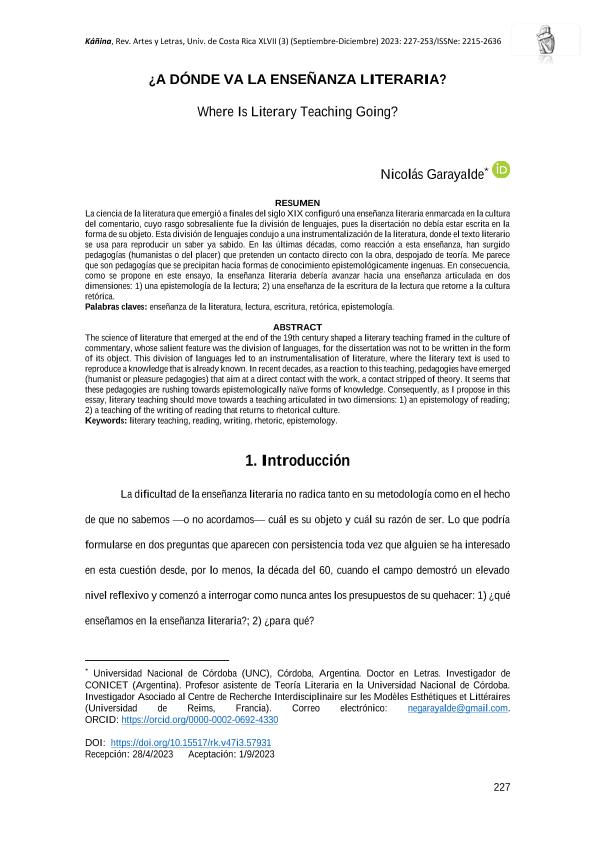Mostrar el registro sencillo del ítem
dc.contributor.author
Garayalde, Nicolas

dc.date.available
2024-02-08T11:57:56Z
dc.date.issued
2023-12
dc.identifier.citation
Garayalde, Nicolas; ¿A dónde va la enseñanza literaria?; Universidad de Costa Rica. Facultad de Letras. Escuela de Filología, Lingüística y Literatura; Kañina; 47; 3; 12-2023; 227-253
dc.identifier.issn
0378-0473
dc.identifier.uri
http://hdl.handle.net/11336/226298
dc.description.abstract
La ciencia de la literatura que emergió a finales del siglo XIX configuró una enseñanza literaria enmarcada en la cultura del comentario, cuyo rasgo sobresaliente fue la división de lenguajes, pues la disertación no debía estar escrita en la forma de su objeto. Esta división de lenguajes condujo a una instrumentalización de la literatura, donde el texto literario se usa para reproducir un saber ya sabido. En las últimas décadas, como reacción a esta enseñanza, han surgido pedagogías (humanistas o del placer) que pretenden un contacto directo con la obra, despojado de teoría. Me parece que son pedagogías que se precipitan hacia formas de conocimiento epistemológicamente ingenuas. En consecuencia, como se propone en este ensayo, la enseñanza literaria debería avanzar hacia una enseñanza articulada en dos dimensiones: 1) una epistemología de la lectura; 2) una enseñanza de la escritura de la lectura que retorne a la cultura retórica.
dc.description.abstract
The science of literature that emerged at the end of the 19th century shaped a literary teaching framed in the culture of commentary, whose salient feature was the division of languages, for the dissertation was not to be written in the form of its object. This division of languages led to an instrumentalisation of literature, where the literary text is used to reproduce a knowledge that is already known. In recent decades, as a reaction to this teaching, pedagogies have emerged (humanist or pleasure pedagogies) that aim at a direct contact with the work, a contact stripped of theory. It seems that these pedagogies are rushing towards epistemologically naïve forms of knowledge. Consequently, as I propose in this essay, literary teaching should move towards a teaching articulated in two dimensions: 1) an epistemology of reading; 2) a teaching of the writing of reading that returns to rhetorical culture.
dc.format
application/pdf
dc.language.iso
spa
dc.publisher
Universidad de Costa Rica. Facultad de Letras. Escuela de Filología, Lingüística y Literatura
dc.rights
info:eu-repo/semantics/openAccess
dc.rights.uri
https://creativecommons.org/licenses/by-nc-nd/2.5/ar/
dc.subject
ENSEÑANZA
dc.subject
LECTURA
dc.subject
ESCRITURA
dc.subject
RETÓRICA
dc.subject.classification
Estudios Generales de Literatura

dc.subject.classification
Lengua y Literatura

dc.subject.classification
HUMANIDADES

dc.title
¿A dónde va la enseñanza literaria?
dc.title
Where Is Literary Teaching Going?
dc.type
info:eu-repo/semantics/article
dc.type
info:ar-repo/semantics/artículo
dc.type
info:eu-repo/semantics/publishedVersion
dc.date.updated
2024-02-08T10:15:14Z
dc.identifier.eissn
2215-2636
dc.journal.volume
47
dc.journal.number
3
dc.journal.pagination
227-253
dc.journal.pais
Costa Rica

dc.journal.ciudad
San José de Costa Rica
dc.description.fil
Fil: Garayalde, Nicolas. Consejo Nacional de Investigaciones Científicas y Técnicas. Centro Científico Tecnológico Conicet - Córdoba. Instituto de Humanidades. Universidad Nacional de Córdoba. Instituto de Humanidades; Argentina
dc.journal.title
Kañina
dc.relation.alternativeid
info:eu-repo/semantics/altIdentifier/url/https://revistas.ucr.ac.cr/index.php/kanina/article/view/57931
dc.relation.alternativeid
info:eu-repo/semantics/altIdentifier/doi/https://doi.org/10.15517/rk.v47i3.57931
Archivos asociados
